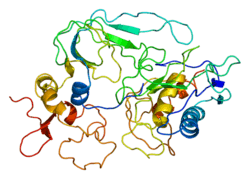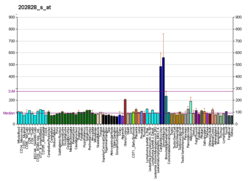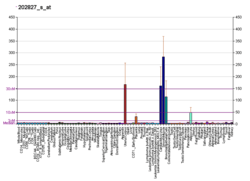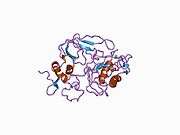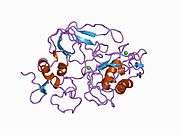MMP14
Matrix metalloproteinase-14 is an enzyme that in humans is encoded by the MMP14 gene.[4]
Function
Proteins of the matrix metalloproteinase (MMP) family are involved in the breakdown of extracellular matrix in normal physiological processes, such as embryonic development, reproduction, and tissue remodeling, as well as in disease processes, such as arthritis and metastasis. Deficits in MMP14 leads to premature aging, short lifespan, and cell senescence in mice,[5] suggesting an important role of MMP14 in extracellular matrix remodeling during aging. Most MMP's are secreted as inactive pro-proteins which are activated when cleaved by extracellular proteinases.
However, the protein encoded by this gene is a member of the membrane-type MMP (MT-MMP) subfamily; each member of this subfamily contains a potential transmembrane domain suggesting that these proteins are tethered to the cell surface rather than secreted.
"This protein activates MMP2 protein, and this activity may be involved in tumor invasion."[6]
Interactions
MMP14 has been shown to interact with TIMP2.[7]
See also
- Matrix metalloproteinase
- ARK5
References
- GRCh38: Ensembl release 89: ENSG00000157227 - Ensembl, May 2017
- "Human PubMed Reference:". National Center for Biotechnology Information, U.S. National Library of Medicine.
- "Mouse PubMed Reference:". National Center for Biotechnology Information, U.S. National Library of Medicine.
- Sato H, Takino T, Okada Y, Cao J, Shinagawa A, Yamamoto E, Seiki M (Jul 1994). "A matrix metalloproteinase expressed on the surface of invasive tumour cells". Nature. 370 (6484): 61–5. doi:10.1038/370061a0. PMID 8015608.
- Gutiérrez‐Fernández, Ana; Soria‐Valles, Clara; Osorio, Fernando G.; Gutiérrez‐Abril, Jesús; Garabaya, Cecilia; Aguirre, Alina; Fueyo, Antonio; Fernández‐García, María Soledad; Puente, Xose S. (2015-07-14). "Loss of MT1‐MMP causes cell senescence and nuclear defects which can be reversed by retinoic acid". The EMBO Journal. 34 (14): 1875–1888. doi:10.15252/embj.201490594. ISSN 0261-4189. PMC 4547893. PMID 25991604.
- "Entrez Gene: MMP14 matrix metallopeptidase 14 (membrane-inserted)".
- Zucker S, Drews M, Conner C, Foda HD, DeClerck YA, Langley KE, Bahou WF, Docherty AJ, Cao J (Jan 1998). "Tissue inhibitor of metalloproteinase-2 (TIMP-2) binds to the catalytic domain of the cell surface receptor, membrane type 1-matrix metalloproteinase 1 (MT1-MMP)". J. Biol. Chem. 273 (2): 1216–22. doi:10.1074/jbc.273.2.1216. PMID 9422789.
Further reading
- Nagase H, Woessner JF (1999). "Matrix metalloproteinases". J. Biol. Chem. 274 (31): 21491–4. doi:10.1074/jbc.274.31.21491. PMID 10419448.
